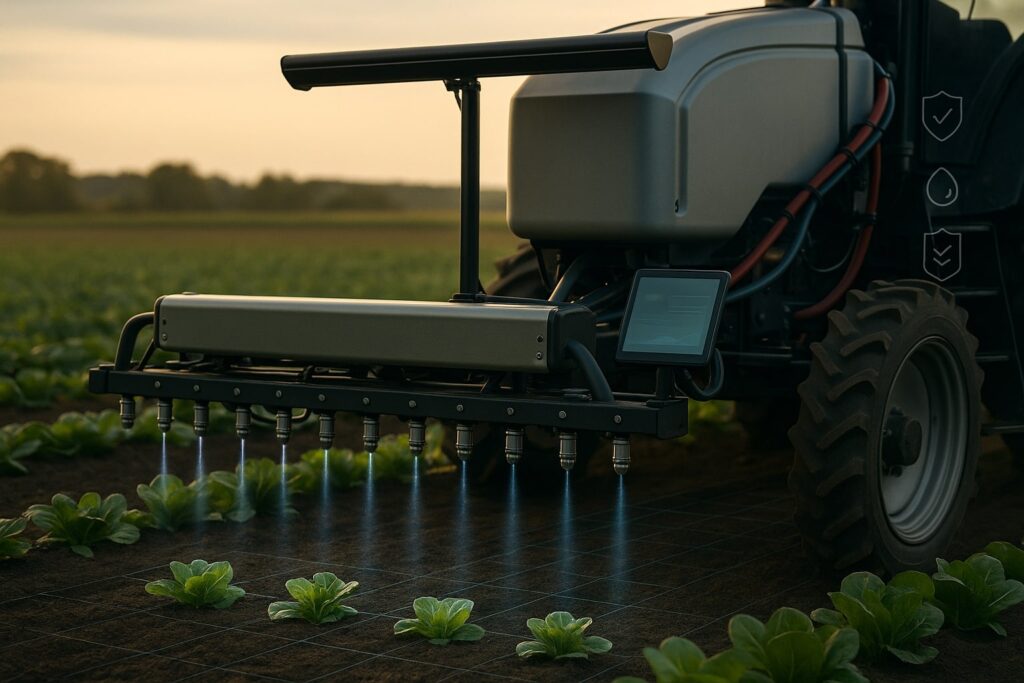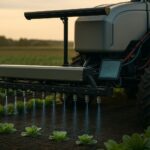A Swiss start-up’s funding coup hints at the next competitive front in farm inputs: centimetre‑scale application, compliance-ready data logs and a new liability regime for AI in machinery.
On October 13, Switzerland’s Ecorobotix said it has secured $150mn across a 2024 Series C and a 2025 Series D to accelerate its Plant‑by‑Plant™ artificial‑intelligence spraying platform—and promised a new product unveiling at Agritechnica in November. The D round is led by Highland Europe with ECBF and McWin joining; long‑time backers include BASF Venture Capital and Yara Growth Ventures. The company claims its vision‑guided sprayer can cut chemical use by “as much as 95%”. In a consolidating ag equipment market hungry for credible input savings—and with Europe tightening the rules for AI embedded in machines—the timing is no accident.
Table of Contents
ToggleWhat is actually new here?
Ecorobotix’s flagship ARA is not a camera add‑on bolted to an existing 36‑metre boom. It is a purpose‑built, towed implement that treats—rather than sprays—using an array of 156 independently actuated nozzles that fire only over detected weeds or crop targets within a 6×6 cm footprint. Working width is 6.0 m, typical field speed 7.2 km/h, with field capacity up to 4 ha/hour—by industry standards a narrow and deliberate machine, built for precision rather than blanket coverage.
Field evidence from growers is now emerging at scale. At Agromačaj in Slovakia (12,000 ha), switching to ARA cut spray volume from 200 L/ha to 28.2 L/ha—an 86% reduction in the first year—while holding efficacy and easing residue compliance for retailers.
How it stacks up against camera‑boom retrofits
The major sprayer platforms—John Deere (See & Spray), Greeneye (retrofit) and ONE SMART SPRAY (Bosch–BASF)—are all pursuing targeted applications, typically as a mode on a standard boom. Their data points are becoming more consistent:
- John Deere reports ~59% average herbicide savings in 2024 across >1 million acres; a three‑year field trial in Arkansas soybeans found 43–59% savings with correct settings.
- Greeneye reports an 87% average reduction in non‑residual herbicides (typical savings $25–35/acre), rising to 92% in pre‑emergence; independent extension notes savings compress when weed pressure is high.
- The ONE SMART SPRAY EU LIFE trials show €9–€78/ha savings with efficacy equivalent to broadcast in many crops; payback for large farms 2–3 years.
Ecorobotix sits at the extreme end of this spectrum. With 6×6 cm resolution and a sealed imaging bay that works day and night, its thesis is less about “saving some chemistry” and more about enabling chemistries and operations that were previously impractical—such as using non‑selective products safely inside vegetable rows, or performing automated lettuce thinning—because the system “treats” specific plant tissue rather than spraying zones. The company has begun rolling out 2026 algorithms precisely for those tasks.
The capex curve—and why the business model matters
Hardware matters to farmers, but so do payment models. Retrofits can be cheaper upfront but often come with ongoing fees. Deere’s See & Spray Premium upgrade has been marketed with limited‑time hardware incentives but a per‑acre license ($1/acre fallow; $5/acre in‑crop). Greeneye sells its kit without a subscription, with retrofit packages quoted $180k–$270k depending on sprayer and options. Ecorobotix, by contrast, is selling a dedicated implement; third‑party investor commentary pegs ARA’s list price at ~€200k. That spread shapes payback maths as much as any headline “% savings” claim.
The maths of not spraying the air
Two simple scenarios illustrate how the economics shift from “nice‑to‑have” to “mandate”:
- US summer fallow: Montana State’s precision trials estimate $43.5–$45.5/acre savings using spot‑spray modes while maintaining control. On a 10,000‑acre wheat farm, that is $435k–$455k a season before yield effects.
- EU cereals: Teagasc pegs typical herbicide costs at €86–€109/ha (spring barley to winter barley). A conservative 50–70% reduction implies €43–€76/ha saved; at 1,500 ha that is €64k–€114k per season—without counting reduced drift risks or retailer residue compliance premia.
Add agronomic second‑order effects. Deere dealers cite 3–4 bu/acre soybean yield gains when crops are spared collateral dose, which at $10/bu is $30–$40/acre—often worth as much as the chemistry saving. (Results are farm‑specific and depend on settings, weed pressure and residual programmes.)

The missed angle: regulation and liability will decide the winners
The EU AI Act is no longer hypothetical. It entered into force in August 2024; governance and general‑purpose AI rules became applicable in August 2025; most obligations apply from August 2026; and high‑risk AI embedded in regulated products—which will include many machine‑mounted AI systems—benefit from an extended transition to August 2027. For providers, this means risk management, data governance, logging, human oversight and accuracy/robustness requirements. Systems that act on a crop with chemicals will need detailed event logs (“why this nozzle fired”) and post‑hoc traceability. Those who can already export clean logs will have a head start with auditors and insurers.
Liability is also shifting. The revised EU Product Liability Directive (2024/2853)—in force since December 2024 and due to be transposed by December 2026—explicitly extends strict liability to software and AI as “products”. Meanwhile, the separate AI Liability Directive proposal was withdrawn this year, leaving the new PLD to carry much of the burden for defect claims. In practice, that pushes ag‑AI suppliers to prove their models were trained responsibly, decisions were logged, and safety mitigations were in place. Again, systems architected for auditability—rather than just headline accuracy—will gain an edge.
Competitive dynamics: specialists vs platforms
Ecorobotix is aiming to be the category specialist for ultra‑high‑precision jobs—vegetables, high‑value leaves, volunteer control in seed crops—where every centimetre and every droplet matters. It is expanding via dealers such as RDO Equipment in Australia and says it now supports 25+ crop algorithms in 20+ countries across Europe, the Americas and Oceania.
The platforms—Deere, CNH (Raven/Augmenta), and Bosch–BASF’s ONE SMART SPRAY—are weaving spot‑spray into mainstream rigs. The bet here is different: keep the big boom, add AI “modes” and let the farmer toggle between residual broadcast and targeted foliar in one pass, with per‑acre pricing and dealer support. CNH’s SenseApply™ and Bosch–BASF’s current field results show the model is maturing; the open question is whether centimetre‑scale treatment becomes a new class of operation (Ecorobotix’s premise), rather than just a new mode.
Practical constraints the hype slides over
- Speed windows: A 6 m implement at ~4 ha/h must keep moving to cover area; weather and labour constraints matter. The counter is that night operation and centimetre‑level precision create new windows when broadcast would be off‑label or unwise.
- Weed pressure: Targeted savings collapse when fields are carpeted with weeds; Minnesota extension logged scenarios with low single‑digit savings at high pressure. Resetting the seedbank via residuals and rotation still matters.
- Chemistry scope: Many headline reductions refer to non‑residual contact herbicides; programmes still need robust residual components. Savings are real but programme‑dependent.
- Drift and stewardship: Less total liquid and tighter spray footprints likely reduce off‑target deposition, but drift hinges on droplet size, boom height and wind; operators still need stewardship training.
What the $150mn buys
For Ecorobotix, the money likely goes to three levers:
- Crop algorithms: Adding models for leeks, garlic, celery, potatoes and ragwort in grassland; sharpening monocot/dicot discrimination; and scaling vegetable‑row non‑selective capability—something the majors do not yet emphasise.
- Geography & channels: Building out distribution (e.g., RDO in Australia) and service capacity to support 24/7 operations during short seasonal windows.
- Compliance & logging: Hardening data pipelines for AI Act conformity assessments and PLD‑ready incident management. (The firm’s press material already highlights audit‑friendly narratives—per‑plant treatment, centimetre footprints, and retailer residue outcomes.)
Investment takeaway
If “variable rate” defined the last wave of precision agriculture, per‑plant looks set to define the next. The majors want it as a feature; Ecorobotix wants it as the system. The regulatory direction in Europe—more documentation, more accountability for AI that acts on the physical world—quietly favours vendors that can prove each spray decision. That is not just a better nozzle. It is a data platform.
For growers, the calculus becomes tractable:
- If you run large booms in row crops with moderate weed pressure, a retrofit mode may deliver $25–$45/acre savings with minimal disruption and dealer support—especially valuable on tens of thousands of acres.
- If you run vegetables, seed crops, onions or manage retailer residue limits, centimetre‑scale treatment can unlock non‑selective options within rows and reduce labour (e.g., thinning), changing both COGS and risk. That is the niche Ecorobotix is building to own.
Bottom line: The real story is not the size of the round. It is that per‑plant treatment—once a research curiosity—is now colliding with regulation that rewards explainable, auditable decisions. If Ecorobotix can pair centimetre precision with the boring (but bankable) disciplines of logging, uptime and service, the “anti‑broadcast” era may finally be investable.




